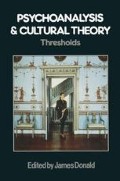Abstract
Although it makes no direct reference to Althusser’s essay of 1970, ‘Ideology and Ideological State Apparatuses’,1 Roland Barthes’s essay of 1973, ‘Diderot, Brecht, Eisenstein’, had the effect of spatialising the Althusserian concept of ideology as representation: ‘there will still be representation for so long as a subject (author, reader, spectator or voyeur) casts his gaze towards a horizon on which he cuts out the base of a triangle, his eye (or his mind) forming the apex’.2 Laura Mulvey’s essay of 1975, ‘Visual Pleasure and Narrative Cinema’,3 subsequently theorised the voyeuristic subject of Barthes’s theatrical space in terms of Freudian psychoanalysis. The change across this five-year period is profound. Instead of a contingent set of ideas which might be dissipated by reason, ‘ideology’ was now conceived of in terms of a space of representations which the subject inhabits, a limitless space which the desiring subject negotiates by predominantly unconscious transactions.
‘simple geometrical opposition becomes tinged with aggressivity’
(Bachelard, The Poetics of Space)
Preview
Unable to display preview. Download preview PDF.
Notes
Louis Althusser, ‘Ideology and Ideological State Apparatuses (Notes To- wards an Investigation)’, in Lenin and Philosophy and Other Essays ( New Left Books, London, 1971 ).
Roland Barthes, ‘Diderot, Brecht, Eisenstein’, in Image-Music-Text ( Hill amp; Wang, New York, 1977 ), p. 69.
Laura Mulvey, ‘Visual Pleasure and Narrative Cinema’, Screen, vol. 16, no. 3, Autumn, 1975.
Michel Foucault, Discipline and Punish ( Penguin, Harmondsworth, 1977 ).
F. M. Cornford, Plato’s Cosmology ( Harcourt Brace, New York, 1937 ).
Augustine, De Ordine, ch. 15, 42; in, A. Hofstadter and R. Kuhns, Philosophies of Art and Beauty ( University of Chicago Press, Chicago, 1976 ), p. 180.
H. Minkowski, ‘Space and Time’, in, A. Sommerfeld (ed.), The Principle of Relativity (Dodd, Mead amp; Co., New York, 1923 ).
Dziga Vertov, ‘Film Directors, A Revolution’, Lef, vol. 3, in Screen Reader I ( SEFT, London, 1977 ), p. 286.
Paul Virilio, L’Espace Critique ( Christian Bourgeois, Paris, 1984 ).
P. Virilio, Speed and Politics, Semiotext(e ), ( New York, 1986 ).
David Bolter, Turing’s Man ( Raleigh, University of North Carolina, 1984 ), p. 98.
Guy Debord, Society of the Spectacle (Black amp; Red, Detroit, 1983), paragraph 167.
Jacqueline Rose, ‘The Imaginary’, in Sexuality in the Field of Vision ( Verso, London, 1986 ).
Jacques Lacan, Le Séminaire, livre I: Les écrits techniques de Freud ( Seuil, Paris, 1975 ), p. 90.
J. Lacan, The Four Fundamental Concepts of Psycho-Analysis ( Hogarth, London, 1977 ), p. 56.
S. Freud, ‘“A Child is Being Beaten”: A Contribution to the Study of the Origin of Sexual Perversions’, SE, XVII, pp. 175–204.
Jean-Paul Sartre, Being and Nothingness ( Washington Square Press, New York, 1966 ), pp. 369–70.
Maurice Merleau-Ponty, The Visible and the Invisible ( Northwestern University Press, Evanston, Ill., 1968 ), p. 139.
Otto Fenichel, ‘The Scoptophilic Instinct and Identification’, in H. Fenichel and D. Rapaport (eds), The Collected Papers of Otto Fenichel, First Series (Norton, New York, 1953 ), p. 375.
A. Manetti, Vita di Filippo di Ser Brunellesco, Elana Tosca (ed.) (Roma, 1927), pp. 11 ff.; quoted in, John White, The Birth and Rebirth of Pictorial Space ( Faber, London, 1971 ), p. 116.
Sarah Kofman, Camera Obscura de l’Idéologie ( Galilée, Paris, 1973 ).
Catherine Clément, The Lives and Legends of Jacques Lacan ( Columbia University Press, New York, 1973 ), p. 160.
Julia Kristeva, La révolution du langage poétique ( Seuil, Paris, 1974 ), p. 453.
J. Kristeva, Pouvoirs de l’horreur ( Seuil, Paris, 1980 ), p. 92.
J. Kristeva, Soleil Noir: Dépression et Mélancolie (Gallimard, Paris, 1987), 107ff.
Klaus Theweleit, Male Fantasies ( Polity, Cambridge, 1987 ).
J. Kristeva, ‘Women’s Time’, in Toril Moi (ed.), The Kristeva Reader ( Basil Blackwell, Oxford, 1986 ), p. 209.
Editor information
Copyright information
© 1991 Victor Burgin
About this chapter
Cite this chapter
Burgin, V. (1991). Geometry and Abjection. In: Donald, J. (eds) Psychoanalysis and Cultural Theory: Thresholds. Communications and Culture. Palgrave, London. https://doi.org/10.1007/978-1-349-21170-8_2
Download citation
DOI: https://doi.org/10.1007/978-1-349-21170-8_2
Publisher Name: Palgrave, London
Print ISBN: 978-0-333-46104-4
Online ISBN: 978-1-349-21170-8
eBook Packages: MedicineMedicine (R0)

